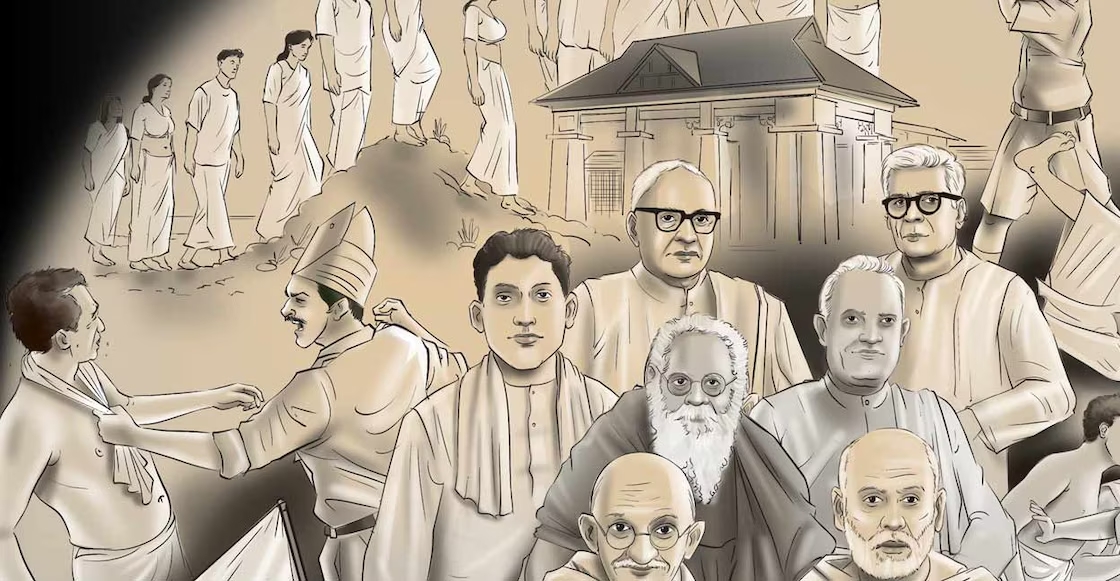Vaikom Satyagraha

- 30 Mar 2024
Why is it in the News?
Vaikom, a temple town in the princely state of Travancore, saw the start of a non-violent agitation on March 30, 1924 — the first among temple entry movements that would soon sweep across the country.
What is Vaikom Satyagraha?
- Vaikom Satyagraha was a significant non-violent protest against the caste-based discrimination prevalent in the princely state of Travancore, characterized by a feudal, militaristic governance system entrenched with rigid social norms and customs.
- Discriminatory practices, such as the prohibition of lower castes like the Ezhavas and Pulayas from temple entry and even walking on roads near temples, were pervasive.
Contribution of Leaders:
- In 1923, the issue was brought to attention as a resolution by Madhavan during the Kakinada meeting of the All India Congress Committee.
- Subsequently, the Kerala Pradesh Congress Committee formed the Congress Untouchability Committee in January 1924 to address the matter.
- Pioneers of the Vaikom Satyagraha movement include Madhavan, K.P. Kesava Menon, then secretary of the Kerala Pradesh Congress Committee, and K. Kelappan, a prominent Congress leader and educationist known as Kerala Gandhi.
Factors Leading to Satyagraha:
- The expansion of Christian missionaries, backed by the East India Company, led to conversions among lower castes seeking liberation from an oppressive system.
- Maharaja Ayilyam Thirunal initiated several progressive reforms, notably the establishment of a modern education system providing free primary education for all, including lower castes.
- These reforms, alongside the influence of capitalism, contributed to the emergence of new social hierarchies, sometimes conflicting with traditional ones.
Commencement of Satyagraha:
- On March 30, 1924, the Satyagrahis embarked on a procession towards the restricted public roads, where a board warned oppressed communities against walking (near the Vaikom Mahadeva temple).
- Despite being halted 50 yards away, individuals such as Govinda Panikkar (Nair), Bahuleyan (Ezhava), and Kunjappu (Pulaya), adorned in khadi attire, courageously defied the prohibition orders.
- Subsequently, they were stopped by the police and, in protest, sat on the road, resulting in their arrest.
- Following this incident, three volunteers from different communities were designated each day to walk on the prohibited roads. Within a week, the movement's leaders were all apprehended by authorities.
Role of Women:
- Large-scale participation of women was witnessed for the first time during the Satyagraha, marking the passage of women into the socio-political consciousness of the country.
- Nagammai, the wife of Periyar, and Kannammal, his sister, played unprecedented roles in the struggle.
Arrival of Gandhi:
- In March 1925, Gandhi arrived at Vaikom and engaged in discussions with leaders from various caste groups.
- He also met with the Maharani Regent at her Varkala camp.
Withdrawal of Vaikom Satyagraha:
- The Vaikom Satyagraha was officially terminated on November 30, 1925, following consultations between Gandhi and W.H. Pitt, the police commissioner of Travancore.
- A compromise was reached, leading to the release of all prisoners and the granting of access to roads.
Temple Entry Proclamation:
- In 1936, the historic Temple Entry Proclamation was signed by the Maharaja of Travancore, abolishing the age-old ban on temple entry.
Significance:
- During a period of growing nationalist fervor and widespread agitation, the Vaikom Satyagraha emerged as a pivotal catalyst for social reform.
- Introducing Gandhian principles of nonviolent resistance to Travancore for the first time, marked a significant departure from traditional modes of protest.
- Enduring for over 600 consecutive days, despite social pressure, police interventions, and even a natural disaster in 1924, the steadfastness of the movement is commendable.
- The Vaikom Satyagraha fostered unprecedented unity across caste lines, showcasing a remarkable display of solidarity among diverse communities.
